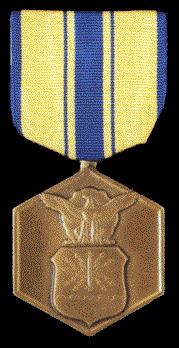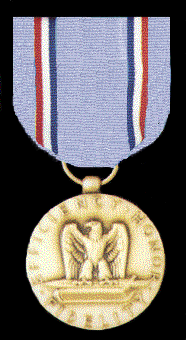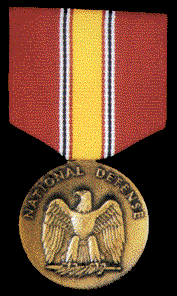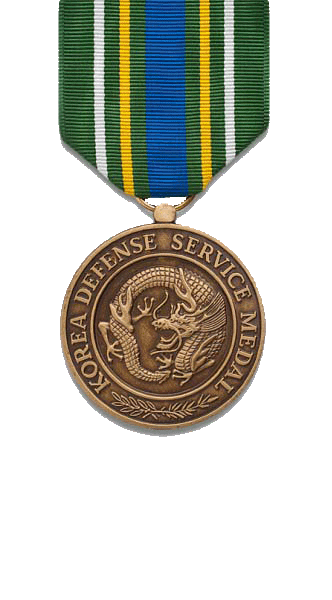 Meritorious Service Medal
Meritorious Service Medal 
 Meritorious Service Medal
Meritorious Service Medal 
This decoration was established by Executive Order 11448 on Jan. 16, 1969. The Meritorious Service Medal (pictured below) may be awarded to any member of the Armed Forces of the United States who distinguishes themselves by either outstanding achievement or meritorious service to the United States.
This award was established as the counterpart of the Bronze Star Medal for the recognition of meritorious noncombat service.
The medal was designed by Jay Morris and sculptered by Lewis J. King, Jr., both of the Army's Institute of Heraldry. It is a one and one-half inch medallion in bronze, on the obverse as eagle wings upraised, standing upon two upward curving branches of laurel tied with a ribbon between the talons of the eagle, above and behind the eagle the upper part of a five-pointed star (with two smaller stars outlined within) on a incised plaque with six points starting at the top of each wing of the eagle. The reverse is plain with a circular inscription in raised letters, "United States of America" and "Meritorious Service" separated by dots.
The ribbon is purplish red with a quarter inch white stripe one-eighth inch from each edge.
(Weighted Airman Promoted System Point Value: 5) Commendation Medal
Commendation Medal 
This medal was authorized by the Secretary of the Air Force on March 28, 1958, for award to members of the Armed Forces of the United States who, while serving in any capacity with the Air Force after March 24, 1958, shall have distinguished themselves by meritorious achievement and service. The degree of merit must be distinctive, though it need not be unique. Acts of courage which do not involve the voluntary risk of life required for the Soldier's Medal (or the Airman's Medal now authorized for the Air Force) may be considered for the AFCM.
The medal (pictured below) is a bronze hexagon, with one point up, centered upon which is the seal of the Air Force, an eagle with wings spread, facing left, perched upon a baton. There are clouds in the background. Below the seal is a shield bearing a pair of flyer's wings and a vertical baton with an eagle's claw at either end; behind the shield are eight lightning bolts.
An example of the citation that usually accompanies the award of the Air Force Commendation follows, "Captain Evans A. Kerrigan distinguished himself by meritorious service as Instructor Navigator and Standardization/Evaluation Instructor, KC-135, 509th Air Refueling Squadron, 509th Bombardment Wing, SAC, Pease Air Force Base, New Hampshire, February 19, 1984 to May 16, 1988. During this period, Captain Kerrigan's superior performance and outstanding dedication led to significant improvements in the unit's combat readiness, contributing immeasurably to the performance of its worldwide missions. The distinctive accomplishments of Captain Kerrigan reflect credit upon himself and the United States Air Force."
A bronze oak leaf cluster is awarded for each additional award of the AFCM. Award of the "V" device for a contingency deployment operation will be dependent upon the area of responsibility (AOR) being declared a hostile environment by the JCS, or hostile acts identified by the unified commander or higher authority. Award of the "V" device is authorized only for events or situations which occured on or after 11 Jan 96.
(Weighted Airman Promoted System Point Value: 3) Outstanding Unit Award
Outstanding Unit Award
The Air Force Outstanding Unit Award was authorized by Department of the Air Force General Order 1, Jan. 6, 1954. It is awarded by the Secretary of the Air Force to numbered units which have distinguished themselves by exceptionally meritorious service or outstanding achievement that clearly sets the unit above and apart from similar units, the services include; performance of exceptionally meritorious service, accomplishment of a specific outstanding achievement of national or international significance, combat operations against an armed enemy of the United States, or military operations involving conflict with or exposure to hostile actions by an opposing foreign force.
The ribbon has a narrow red stripe, flanked by a thin white stripe, a wide blue stripe, a thin white stripe, edged with a narrow red stripe. A bronze "V" device is worn on the ribbon to denote award for combat or direct combat support actions.
 Good Conduct Medal
Good Conduct Medal 
This medal (pictured below) was authorized by Congress on July 6, 1960, with the creation of the other medals of the Air Force. The medal was not created until June 1, 1963 when the Secretary of the Air Force established it. It is awarded to Air Force enlisted personnel for exemplary conduct during a three-year period of active military service, (or for a one-year period of service during a time of war). Persons awarded this medal must have had character and efficiency ratings of excellent or higher throughout the qualifying period, including time spent in attendance at service schools, and there must have been no convictions of court martial during this period. Air Force personnel who were previously awarded the Army Good Conduct Medal and after June 1, 1963 qualified for the Air Force Good Conduct Medal could wear both medals.
The medal is the same as the Army Good Conduct Medal and was designed by Joseph Kiselewski. On the obverse is an American eagle with wings displayed and inverted, standing on a closed book and a Roman sword. Encircling this are the words "Efficiency, Honor, Fidelity" at the medal's outer edge. The reverse has a five-pointed star above a blank scroll suitable for engraving the recipient's name and above the star are the words, "For Good" and below the scroll "Conduct." Is encircled by a wreath of laurel and oak leaves.
The ribbon is predominantly light blue with a tin stripe of dark blue, thin stripe of white, thin stripe of red and a thin stripe of light blue at the edge.
 National Defense Medal
National Defense Medal 
This medal (pictured below) was authorized by Executive Order 10448, April 22, 1953, and amended by Executive Order 11256, Jan. 11, 1966. It is awarded for honorable active military service as a member of the Armed Forces of the United States including the Coast Guard, between June 27, 1950 and July 27, 1954, (Korean War Period), between Jan. 1, 1961 and Aug. 14, 1974, (Vietnam War Period), and 2 Aug 90 to 30 Nov 95 (Desert Shield/Storm Period).
The medal was designed by the Army of Heraldic Section. The obverse shows the American bald eagle, perched on a sword and palm. Above this , in a semicircle, is the inscription "National Defense." The reverse shows a shield, as it appears in the Great Scal of the United States; it is half encircled below with an oak leaf to left an laurel spray to the right, knotted in the center.
The ribbon has a wide yellow stripe in the center, flanked by narrow stripes of red, white, blue, white, wide red stripes.
Service members who earned the medal during the first qualifying period and who again became entitled to the medal wear a bronze star on the ribbon to denote the second award of the medal.
 Korea Defense Service Medal
Korea Defense Service Medal 
This medal (pictured below) was authorized by Executive Order 10448, April 22, 1953, and amended by Executive Order 11256, Jan. 11, 1966. It is awarded for honorable active military service as a member of the Armed Forces of the United States including the Coast Guard, between June 27, 1950 and July 27, 1954, (Korean War Period), between Jan. 1, 1961 and Aug. 14, 1974, (Vietnam War Period), and 2 Aug 90 to 30 Nov 95 (Desert Shield/Storm Period).
 Overseas Service Ribbon (Short Tour)
Overseas Service Ribbon (Short Tour)
Authorized by the Chief of Staff, U.S. Air Force, October 12, 1980.
Before January 6, 1986, the ribbon was awarded to Air Force and Air Force Reserve members credited with completion of an overseas tour on or after September 1, 1980. Air Force and Air Force Reserve members serving as of January 6, 1986, or later are entitled to reflect all Air Force overseas tours credited during their career. A Service member may wear both ribbons, if appropriate. The short tour ribbon takes precedence over the long-tour ribbon when both are worn. Subsequent awards are denoted by oak leaf clusters.
 Overseas Service Ribbon (Long Tour)
Overseas Service Ribbon (Long Tour)
Authorized by the Chief of Staff, U.S. Air Force, October 12, 1980.
Before January 6, 1986, the ribbon was awarded to Air Force and Air Force Reserve members
credited with completion of an overseas tour on or after September 1, 1980. Air Force and
Air Force Reserve members serving as of January 6, 1986, or later are entitled to reflect
all Air Force overseas tours credited during their career. A Service member may wear both
ribbons, if appropriate. The short tour ribbon takes precedence over the long-tour ribbon
when both are worn. Subsequent awards are denoted by oak leaf clusters.
 Longevity Service Award Ribbon
Longevity Service Award Ribbon
The Department of the Air Force General Order 60, Nov. 25, 1957 authorized this ribbon. It is awarded to all service members of the U.S. Air Force who complete four years of honorable active or reserve military service with any branch of the United States Armed Forces. The Air Force Longevity Service Award is a ribbon that replaces the Federal Service Stripes previously worn on the uniform.
The ribbon is ultramarine blue divided by four equal stripes of turquoise. Bronze oak-leaf clusters are worn on the ribbon to indicate subsequent awards of the Air Force Longevity Service Award.
 NCO PME Graduation Ribbon
NCO PME Graduation Ribbon
This award, authorized by the Secretary of the Air Force, 28 August 1962, is awarded to graduates of the following certified NCO PME schools (NCO Preparatory Course, Airman Leadership School, NCO Leadership School, NCO Academy, SRNCO Academy. Graduation from each successive level of PME entitles the member to an oak leaf cluster. Do not award the ribbon to members who only complete the correspondence courses or similar training conducted by other military services except for completion of the U.S. Army Sergeant Major Academy or the Navy Senior Enlisted Academy.
 Small Arms Expert Marksmanship Ribbon
Small Arms Expert Marksmanship Ribbon
This ribbon was authorized by the Secretary of the Air Force on Aug. 28, 1962. It is awarded to all U.S. Air Force service members who, after Jan. 1, 1963, qualify as "expert" in small-arms marksmanship with either the M-16 rifle or issue handgun. These rules will apply to the Air Force standard service small arms weapon selected. Qualifications as "expert" in both weapons after June 22, 1972, shall be denoted by a bronze service star worn on the ribbon.
The ribbon has a very wide center stripe of laurel green, flanked on either side by a thin yellow stripe, with a wide light blue stripe at the edges.
 Training Ribbon
Training Ribbon
This ribbon was authorized by the Chief of Staff, U.S. Air Force on Oct. 12, 1980. It is awarded to U.S. Air Force service members on completion of initial accession training after Aug. 14, 1974. The ribbon was designed by the Institute of Heraldry. The ribbon has a wide center stripe of red, flanked on either side by a wide stripe of dark blue and a narrow yellow stripe edged by a narrow dark blue stripe.
| Bill & Jackie's |
 |